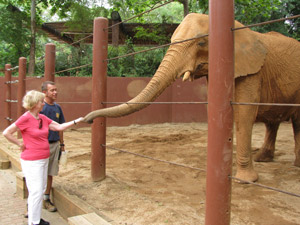What’s a good thing to do with a bunch of kids on a summer day? Go to the zoo! I’ve never gotten over my childhood love of zoos. I took my kids, and now I take theirs (you can share a memorable visit to the zoo with my grandchildren in Reaching the Animal Mind, Chapter 5, Creativity).

Curator Adam Stone persuades Karen to
feed an African elephant through the bars.
(click here to enlarge)
When I was little, most zoos consisted of a series of cement-floored, iron-barred cages with a different kind of animal in each cage. One zookeeper told me that in those days he hired as zookeepers “…anyone who could see lightning and hear thunder.” They had to be men, too; the main jobs of a zookeeper were to shovel food in and droppings out, and to handle heavy loads such as bales of hay.
Now it’s completely different. Zoos have evolved into scientific and conservation organizations. Many species are kept in “natural” habitats that provide at least some of the elements, like nest holes and mud wallows, that would make those animals comfortable in the wild. Zoos keep elaborate international breeding records so individuals of a given species can be tracked and swapped around to maintain genetic variability in the captive population. Curators have PhDs and accomplish valuable research. Keepers are often biologists, ecologists, or animal behaviorists. Lots of them are female. And here’s another big difference: more and more keepers are operant trainers, too.
A day at the zoo
I was in Atlanta this month for the annual conference of the American Veterinary Medicine Association (AVMA) and two other behavior-focused veterinary organizations. A lot of people with pet behavior problems start by asking their vet for advice, and the vets are more and more interested. Approximately 8,500 attendees showed up for the AVMA meetings this year, and it felt as if every one of them came by the Karen Pryor Academy booth to ask about becoming a clicker trainer or finding good clicker trainers for their clients (that’s easy: go to www.greatdogtrainers.com.)
Denver Zoo’s Obedience Rhino
When my work was over, I went to the zoo. I wangled backstage privileges through the help of two graduate students from Georgia Tech, both getting their PhDs in animal behavior analysis. Allison Martin studies and teaches at Yerkes National Primate Research Center in Atlanta. Bonnie Perdue wrote her thesis on panda behavior and is now doing some cognition work with elephants. I gave a talk to the keepers. In return for seeing their animals working, I showed videos of accomplishments in other zoos, including my favorite: Denver Zoo’s Obedience Rhino. On cue he offers sit, down, roll over, and hold still for medical care, all for a whistle and—the primary reinforcer each time—one grape.
Here’s what we saw at the zoo: a giant male silverback gorilla, elderly (47) and with a heart condition, calmly and cheerfully sticking his arm into a metal tunnel and getting his blood pressure taken. I’m impressed; I’ve never been terribly happy about doing that behavior myself. Of course nobody gives me grapes for it.
Then we saw panda training. The panda comes to the bars, presents her paws, ears, eyes (for medicating), accepts shots, and patiently stands or sits in position for everything from injections to ultrasound. The pandas look cute, especially those round, wooly ears but don’t be fooled; they are well armed with teeth and claws.
The zoo has five people who do nothing all day but drive around Georgia cutting bamboo. Of the 30 or 40 species of bamboo that grow in Georgia, the pandas will only eat about 10, and then only some parts, sometimes, some days. Each panda goes through what looked to me to be six bushels of bamboo, just for breakfast. This is not an easy animal to keep in captivity.

Animal behaviorists Allison Martin and
Bonnie Perdue with Karen Pryor at the
Zoo Atlanta gorilla habitat.
(click here to enlarge)
We also saw the two African elephants. They were red, not gray. The soil in Georgia is red clay, and the elephants like to cover themselves with dust. Adam Stone, Assistant Curator of Behavioral Management, put one through her paces—lots of learned behavior on verbal cues and targets, but all through the bars in what’s called protected contact. The people are safe from the elephant, and the elephant is safer from the people, too.
As in many zoos today, keepers in different departments are at different levels of skill in their training. But everyone is trying to learn more; even birds and reptiles get positive reinforcement for cooperating in medical care and general husbandry and handling. It’s a transformation for the zoos, a fascinating new way to interact with the animals for the keepers, and, in some cases, a life-saving, or even a species-saving, technology. Click!



Post new comment